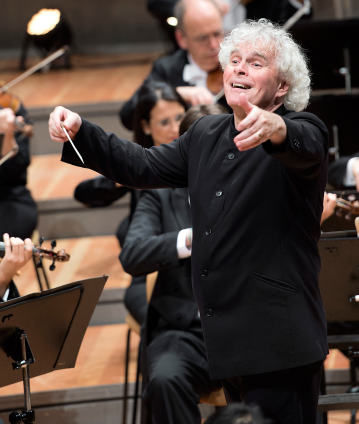Simon Rattle conducts Beethoven’s Symphonies Nos. 4 and 7

Like a “slender Greek maiden between two Nordic giants” – that’s the effect Beethoven’s Fourth Symphony made on Robert Schumann. However, this maiden is anything but harmless; she repeatedly shows a biting humour. This humour becomes still greater in the almost manic verve of the Seventh Symphony. At the same time, the work is steeped in a melancholy flavour that develops unchecked in the famous darkly striding Allegretto.
Beethoven began working on his Fifth Symphony in 1804, even before finishing the Eroica. Before the piece was completed in the spring of 1808, however, the composer chose to set himself to yet another symphonic work: the conceptually evidently less problematic Fourth, which appears in the words of Robert Schumann like a “slender Greek maiden between two Nordic giants”, whereby “Greek” – no doubt intended positively by Schumann – probably stands primarily for “classical”, i.e. “in accordance with known form”. In 1844 Hector Berlioz wrote about this work, with which Sir Simon Rattle continues his Beethoven cycle: “Here Beethoven leaves ode and elegy completely to return to the less sublime and less gloomy but perhaps no less difficult style of the second symphony. The general character of the score is lively and alert, of a celestial sweetness.”
Four years after the Fifth and Sixth Symphonies, Beethoven then composed his Seventh, premiered jointly on 8 December 1813 with the resounding portrait of a battle Wellington’s Victory or The Battle of Vittoria op. 91 at a charity concert “in the best interest of the Austrian and Bavarian soldiers who became invalids in Hanau”. Thus, his contemporaries understood the two works to represent the unity of “battle” and “victory”. Through late February 1814 there were two repeat performances at each of which the second movement – deemed by the press “the crown of the newer instrumental music” – had to be played again. It’s no wonder that Beethoven’s Seventh with its vision of victory in the first movement, the hymn-like passages of the Scherzo and the ecstatic rhythms of the Finale became extremely popular within a very short time. The reviewer of the Leipzig Allgemeine musikalische Zeitung described the work as the “most melodious, most pleasing and most comprehensible among all Beethoven’s symphonies”. More than a century later, Theodor W. Adorno even called the piece “the symphony par excellence”.
© 2015 Berlin Phil Media GmbH
Artists
Our recommendations
- Beethoven’s Piano Concerto No. 4 with Mitsuko Uchida and Simon Rattle
- Simon Rattle and Daniel Barenboim play Brahms
- Simon Rattle conducts Schumann and Dutilleux
- Simon Rattle conducts Brahms, Debussy and Haas
- Anniversary concert “50 years of the Berlin Philharmonie”
- Simon Rattle conducts Berlin school orchestras